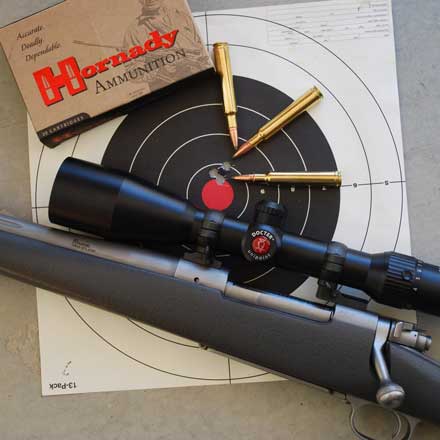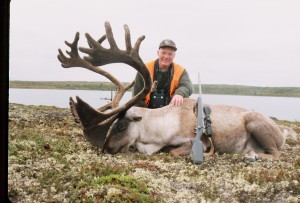
When I was new shooter in the 1960s, we were in a serious magnum craze, when all the new cartridges bore a “magnum” suffix, and we believed velocity was king. That seemed to die down a bit, but in recent years, we’ve seen a resurgence of magnum mania with a whole spate of long, short, super short, and “ultra” magnums promising new levels of performance.
The new cartridges all pretty do what they’re supposed to do, but there really isn’t all that much new under the sun. Quite a few of our red-hot magnums actually date back to Roy E. Weatherby’s developments in the 1940s. In some calibers, there are some newer cartridges that exceed Weatherby velocities, but only by a relatively small margin. The flagship of the Weatherby line is the .300 Weatherby Magnum developed in 1944, and thus past retirement age. But still popular, still fast, and still very useful.
I’ve written before about the numerous fast .30-caliber cartridges. All are powerful and versatile, fine choices for open-country use, pretty good for game larger than deer, and especially comforting in unfamiliar situations where you aren’t quite sure what to expect. Without question the .300 Winchester Magnum is the most popular of the group. The unbelted .300 Remington Ultra Mag arguably may be the best of the fast .30s, but I have a soft spot for the great old .300 Weatherby. It is unquestionably faster than Winchester’s cartridge. It does not have as much powder capacity as the .300 RUM, so if we compare apples to apples (handloads to handloads), it cannot be as fast. But it is much more popular and much more available, with good factory loads from several makers, as well as Weatherby’s own selection.
I have a fairly long history with the cartridge. I acquired a Weatherby Mark V in .300 Weatherby back in 1982. This was just after a disastrous burglary, so for quite some time it was just about the only versatile centerfire I owned, and I used it quite a lot. That rifle had a 26-inch barrel, which this cartridge really needs to strut its stuff. So one of the things I quickly learned is such a rifle isn’t particularly handy in a whitetail stand! But I also learned that it’s a marvelous choice in open country, whether mountains or plains, and, although it’s more powerful than needed for deer-sized game, its velocity allows its bullets to buck the wind well, and gives the .30-caliber tremendous versatility for elk, moose, bear, and the general run...
of larger African plains game.
Back in the mid-90s, Lex Webernick, of Rifles, Inc., built me a .300 Weatherby Magnum on one of the rare left-hand stainless steel Model 70 Classic actions. I didn’t want a muzzle brake, so I asked Lex not to make it too light. The rifle wears a fluted 26-inch barrel with a synthetic stock. With a full-sized scope, it weighs a bit over nine pounds, which is surely not light, but this keeps the recoil manageable. I freely admit that I’m not particularly loyal to any rifle. After all, it’s part of my job to write about different guns, right? But that Rifles, Inc. in .300 Weatherby is a rifle to which I keep coming back.

Just recently, in February 2011, I took it on a long hunt in Pakistan, a classic example of a situation where the .300 Weatherby Magnum really shines. I’d be hunting blackbuck in floodplains along the Indus River, and the small-bodied Urial sheep in the arid hills of Baluchistan. You don’t need a .300 Weatherby for such animals. However, I’d also be hunting markhor in the Torghar Mountains. This is a tough, big-bodied wild goat that might be taken at extreme range. I would also be hunting nilgai, a big, tough antelope for which I have tremendous respect, and that hunting would be in close cover. Collectively, this speaks to a fast .30-caliber. I chose the .300 Weatherby Magnum, and it served me well just as it always has.
The .300 Weatherby Magnum as developed by Roy Weatherby is just one of several improved versions of the .300 H&H cartridge. It was created by removing the body taper to increase powder capacity, and like all of Roy Weatherby’s cartridges, it has his signature “double Venturi” rounded shoulder, which makes it very recognizable. It uses the full-length .300 H&H case (or .375 H&H case necked down), with a case length of 2.811 inches. This means that a full-length (.375 length) action must be used. The majority of factory rifles so chambered have come from Weatherby, but it has also long been a popular custom chambering, like my .300 Weatherby on a full-length Model 70 action.
Ammunition for the .300 Weatherby Magnum is currently available from...
Federal, Hornady, Remington, and of course Weatherby. Bullet weights include 150, 165, 180, 200, and 220 grains (though only Weatherby offers this full range). Velocities vary quite a bit from company to company. Weatherby ammunition is easily the fastest. This is because European standards are different than ours. Weatherby’s ammo, loaded by Norma has bit higher pressure than ours. Also, Weatherby velocities are generally quoted from a 26-inch barrel, while 24-inch tubes are generally the standard for American factory ballistics. It’s also worth noting that only rarely have I been able to concoct handloads that come up to velocities equaling Weatherby factory loads!
So it isn’t exactly a fair comparison, but with any load the .300 Weatherby Magnum is a very fast cartridge. Weatherby’s 150-grain load is rated at 3540 fps- Hornady’s at 3375. Only Weatherby offers 165-grain loads, rated at 3350 fps. Loads in the popular and versatile 180-grain bullet weight range from 3100 (Federal Trophy Bonded Bear Claw) to 3250 fps (Weatherby). Remington’s 200-grain Swift A-Frame is rated at 2925 fps. Weatherby’s 200-grain Nosler Partition runs 3060 fps. Finally, Weatherby’s 220-grain Hornady round-nose load is rated at 2845 fps. These are all pretty darned fast loads!
In the postwar era, the .300 Weatherby Magnum made headlines as the arm of choice for a new generation of globe trotting hunters like Herb Klein and Elgin Gates. Today, the .300 Weatherby has a lot of competition from other fast .30s, but it remains a wonderful choice for big game and big country.